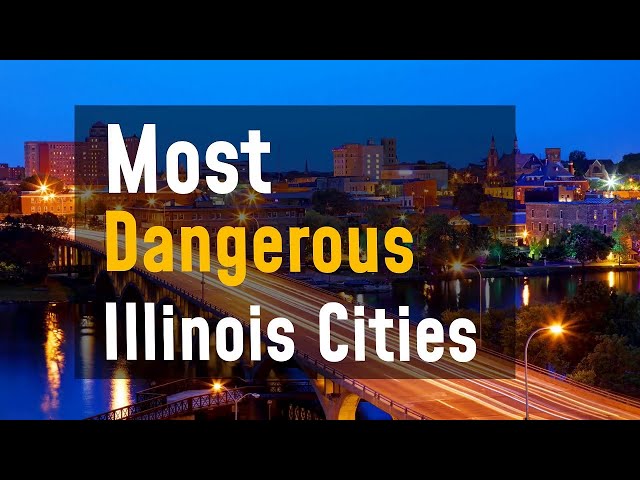Illinois, renowned for its historical significance and dynamic urban centers, also faces serious crime challenges. Understanding the crime landscape of the state’s most dangerous cities is crucial for both residents and visitors to ensure safety and take preventive measures.
Mount Vernon
Mount Vernon, Illinois, frequently appears on lists of high-crime areas due to its elevated rates of violent crime. The city’s violent crime rate stands at 7.42 per 1,000 residents, far exceeding both national and state averages. Residents face a 1 in 135 chance of being victims of serious offenses like rape, murder, armed robbery, and aggravated assault. Property crimes, including burglary and auto theft, are also common, with a rate of 10.29 per 1,000 residents. Despite a recent 58% decrease in crime rates, Mount Vernon remains a focal point for law enforcement and community safety efforts. The city’s crime rate is still 16% above the national average, highlighting ongoing safety concerns.
Danville
Danville has struggled with high crime rates, earning its spot among Illinois’ most dangerous cities. With an overall crime rate of 66 per 1,000 residents, the likelihood of experiencing either violent or property crime is notably high. Violent crime rates, including rape, murder, and aggravated assault, are especially troubling, with a 1 in 57 chance of victimization. Although Danville has implemented community policing initiatives and programs like Project Imagine to address underlying issues and rebuild trust, the city remains in the top 100 most dangerous U.S. cities due to its persistent crime challenges.
Rockford
Rockford’s crime statistics paint a concerning picture, with a violent crime rate of 14.42 per 1,000 residents and a significant prevalence of property crimes, including one of the highest motor vehicle theft rates in the nation. Despite a 20% decrease in violent crimes in 2023, including reductions in aggravated assaults and shootings, property crime rates have seen a slight increase. Rockford’s efforts to improve safety include enhanced police tactics and community programs, such as the Family Peace Center, which supports survivors of domestic violence.
Springfield
Springfield, the state capital, grapples with significant crime issues, with an overall crime rate of 50 per 1,000 residents. Violent crime, including murder and aggravated assault, is more than double the national average. Property crimes, particularly motor vehicle theft, are also prevalent. Despite some efforts to improve safety, such as community programs and increased law enforcement, the city has seen an 8% rise in overall crime year-over-year, underscoring ongoing challenges in ensuring resident safety.
Peoria
Peoria’s crime rate stands at 43 per 1,000 residents, with a particularly high violent crime rate of 11.84 per 1,000. The city faces significant issues with both violent and property crimes, including burglary and larceny. Although there has been a 10% decrease in overall crime, economic factors like a 5.9% unemployment rate contribute to ongoing safety concerns. Peoria’s educational attainment is slightly above average, but economic instability continues to impact crime rates.
Decatur
Decatur’s crime challenges are notable, with an overall crime rate of 32 per 1,000 residents and a high violent crime rate of 7.15 per 1,000. Property crimes are also prevalent, with rates for burglary and motor vehicle theft significantly above national averages. Despite a 3% decrease in crime rates, Decatur struggles with economic factors and a higher-than-average unemployment rate, which contribute to its crime issues. Efforts to improve safety include strengthening law enforcement and community policing strategies.
Champaign
Champaign, home to a prominent university, faces significant crime issues, with an overall crime rate of 23.94 per 1,000 residents. Violent crime, including offenses like robbery and aggravated assault, is notably higher than national averages. Despite a slight downward trend in crime rates and high educational attainment among residents, the city’s crime statistics remain concerning. The lower cost of living may help alleviate some economic pressures contributing to crime.
Joliet
Joliet’s crime rate of 15.41 per 1,000 residents reflects both challenges and improvements. Violent crime rates are higher than state and national averages, while property crime rates are relatively average. The city has seen a general decline in crime, with significant improvements in its homicide rate. Economic stability, including a median home price of $193,100, contributes to the city’s evolving crime dynamics. Crime is concentrated in specific areas, allowing for targeted safety measures.
Metropolis
Metropolis faces significant crime challenges with an overall crime rate of 33.68 per 1,000 residents. Violent crime rates are relatively low, but property crimes, such as burglary and larceny, are notably high. Recent trends show a decrease in violent crime but an increase in property crime. Economic factors, including a lower median home price, may influence crime rates and neighborhood conditions.
Centralia
Centralia’s crime rates are among the highest in Illinois, with an overall rate of 18.02 per 1,000 residents. The city’s violent crime rate is particularly high, making it one of the most dangerous in the state. Although there has been a decrease in property crime rates, they remain above national averages. Centralia’s crime issues are concentrated in specific neighborhoods, making targeted safety measures essential.
Safety Tips for Illinois Residents and Visitors
To stay safe in high-crime areas, follow these essential tips:
- Stay in well-lit, populated areas, especially at night.
- Utilize public transportation cautiously and keep valuables out of sight.
- Use secure parking facilities and avoid leaving items in plain view.
- Remain vigilant when using rideshares or taxis and ensure drivers wait until you’re safely inside your destination.
- Stay informed with local emergency alerts and avoid isolated areas during outdoor activities or large events.
Conclusion
The crime dynamics in Illinois’ most dangerous cities reflect a complex interplay of socioeconomic factors. Addressing these issues requires a multifaceted approach, including economic development, community engagement, and effective law enforcement. By staying informed and taking proactive measures, residents and visitors can enhance their safety in these challenging environments.
Read more at tiblor.com

